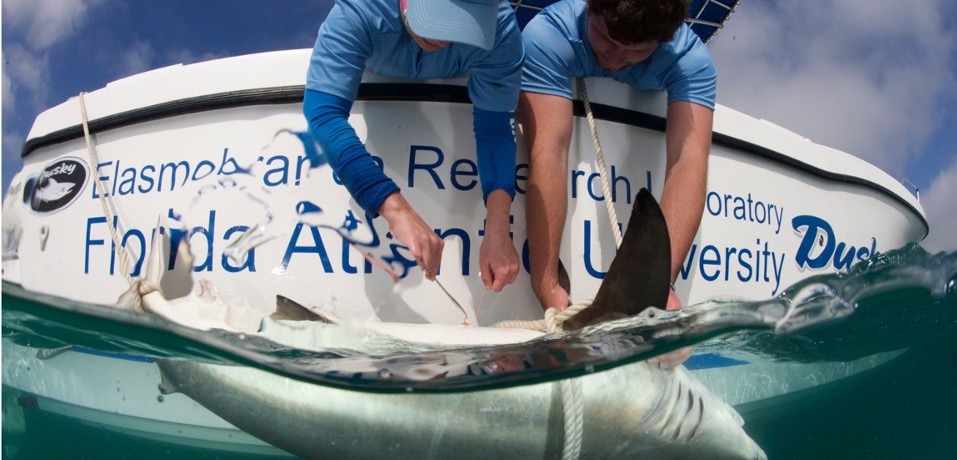
Author and interviewer: Alex Hoey
Date: April 2024
Dr. Beth Bowers, an FAU graduate and Marine Lab alumna, recently accepted an impressive and fitting position as a Postdoctoral Research Fellow at the Smithsonian Environmental Research Center in Edgewater, Maryland. I sat down with Dr. Bowers to discuss the details of her FAU dissertation research, her new career path, and renewable energy!
Dr. Bowers studied the distribution of blacktip sharks (not to be confused with blacktip reef sharks!) along the U.S. eastern seaboard. Blacktips (Carcharinus limbatus) aggregate in large numbers along the coast of southeast Florida each winter during their annual migration. She took to the sea, along with her faculty advisor, Dr. Stephen Kajiura, to learn more about the species. It turned out that most of these blacktips were male. The discovery of sexual segregation (males and females living separately and in different habitats) furthered Dr. Bowers’ curiosity—she wanted to know, not only, where the females were living, but also where the males traveled after they left our coast, and why this difference between the sexes existed! To find out, she used acoustic telemetry.
Acoustic telemetry is an effective way to track animals that travel vast distances. Researchers attach an acoustic transmitter (or tag) onto a study animal. The tag transmits a unique sound to any nearby ocean receiver that is used to identify each animal. Simultaneously, the receiver records the date and time that the animal passes by. Some tags can be programmed to also measure water temperature and/or depth. Thus, acoustic telemetry is an invaluable resource for monitoring migratory behavior and for confirming pathways, especially when receivers can be deployed along suspected migratory corridors.
A large network of acoustic receivers along the Atlantic Coast enabled Dr. Bowers to confirm that male blacktips migrate annually as far north from Florida waters as New York’s Long Island. That was much farther north than originally thought! Females are also migratory, but their movements are restricted temporally to shorter time periods and more circumscribed distances (between Delaware to the north and Georgia or South Carolina to the south).
“We believe this is because the females have an affinity, or requirement, to be near their mating and nursery grounds, perhaps preserving more energy for growth and reproduction than do the males,” said Bowers.
Another aspect of Dr. Bowers dissertation research involved improving the utility of acoustic telemetry in animal tracking. One constraint to acoustic telemetry is animals can only be detected where receivers have been deployed. This means location data often over represents areas where lots of receivers exist and underrepresents areas where they do not. Unless there is an acoustic receiver nearby, an animal’s movement in and around an area cannot be detected by this method. To resolve this bias, Bowers used movement models to reconstruct tracks that filled in the gaps between receiver locations and compared these results against simulated tracks to get a better picture of the sharks’ overall movements.
This was an enormous undertaking and, as Bowers explained, “solved a new problem we didn’t necessarily know we had, because acoustic telemetry and its networks are relatively new.”

|
| Faculty advisor, Dr. Stephen Kajiura, and Dr. Beth Bowers celebrate the beginning of her Postdoctoral SERC Fellowship. |
Dr. Bowers was a prime candidate for her Postdoctoral SERC Fellowship because of her experience in the use of acoustic telemetry and her expertise at meeting the challenges associated with data analyses. Her role in this new position is to develop best practices and standardized methods for evaluating acoustic data from offshore wind-generating devices (aka wind turbines) stationed offshore that generate clean, renewable energy.
While there are currently only two offshore wind farms along the coasts of the U.S., more are slated to be built, especially on the northeast coast. Acoustic telemetry is used to determine which marine species swim in and around the wind farm lease areas, and to evaluate potential impacts of wind farms on marine ecosystems. To maximize the utility of these data, the numbers of observations need to be both accessible and shareable between present and future wind farms. This is where Dr. Bowers’ expertise comes in—she has a strong background in acoustic telemetry and can aid in developing standards for its impact assessments.
Dr. Bowers and her team are creating a guide that standardizes acoustic telemetry use in offshore wind development for researchers and resource managers. She hopes that these guidelines are helpful for all stakeholders. “While we may need to mitigate some impacts that offshore wind will impose on marine ecosystems, we are so far gone with our carbon emission rate that we have to move forward with alternative energy options. We also need to do so in the most responsible way we can.”
It was wonderful to sit down with Dr. Bowers and get a glimpse into how her past endeavors at FAU have shaped her current career path and future. We are so proud of our truly impressive alums!